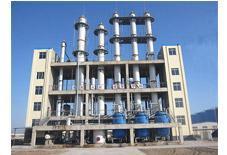As an Ethyl Acetate Plant, share with you.

Ethyl Acetate
Anaerobic biological treatment
Including anaerobic digestion, hydrolysis acidification tank, UASB, etc.
Anaerobic biological treatment is an organic sewage treatment method that uses
facultative anaerobic bacteria and obligate anaerobic bacteria to degrade
macromolecular organic matter in sewage into low-molecular compounds, and then
convert it into methane and carbon dioxide. It is divided into acid digestion
and alkaline digestion. Two stages. In the acid digestion stage. The action of
external enzymes secreted by acid-producing bacteria turns macromolecular
organic matter into simple organic acids and alcohols, aldehyde ammonia, carbon
dioxide, etc.; in the alkaline digestion stage, the metabolites of acid
digestion are further decomposed into methane bacteria under the action of
methane bacteria Biogas composed of methane, carbon dioxide, etc. This treatment
method is mainly used for the treatment of high-concentration organic wastewater
and fecal sewage. Advantages: 1) Low energy consumption 2) Recyclable bioenergy
(biogas) 3) Less microorganisms (sludge) produced per unit mass of substrate
removed 4) The whole process does not require oxygen, so it is not limited by
the oxygen transfer capacity, and it Has a high load capacity
Biological treatment under natural conditions
(1) The stable pond will be properly artificially repaired to build the pond,
and the embankment and anti-seepage layer shall be set up to treat the sewage
depending on the microorganisms growing in the pond. Advantages: 1) Can make
full use of terrain, simple structure and low construction cost. 2) It can
realize sewage resource utilization, sewage recovery and reuse, and realize
water circulation, which not only saves water resources, but also obtains
economic benefits. 3) Low processing energy consumption, easy operation and
maintenance, and low cost. 4) Beautify the environment and form an ecological
landscape. 5) Low sludge output. 6) It can withstand the large-scale fluctuation
of sewage water volume, and its adaptability, impact resistance and ability are
strong. (2) Land treatment method A general term for methods of improving water
quality with soil and plants. At the same time, the water and nutrients of
wastewater are used to nourish the land. The land treatment methods mainly
include irrigation, flood irrigation and high irrigation rate penetration.
Modern sewage treatment technology can be divided into primary, secondary and
tertiary treatment according to the degree of treatment. The primary treatment
mainly removes the solid pollutants in the suspended state in the sewage. Most
of the physical treatment methods can only complete the requirements of the
primary treatment. After the primary treatment of sewage, BOD can generally
remove about 30%, which does not meet the discharge standard. The primary
treatment belongs to the pretreatment of the secondary treatment. The secondary
treatment mainly removes colloidal and dissolved organic pollutants (BOD, COD
substances) in the sewage, and the removal rate can reach more than 90%, so that
the organic pollutants can reach the discharge standard. Tertiary treatment,
further processing of refractory organic matter, nitrogen and phosphorus and
other soluble inorganic substances that can lead to eutrophication of the water
body.
Our company provides Ethyl Acetate, please contact us.














